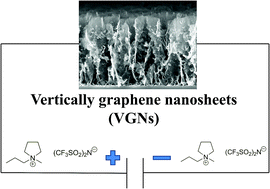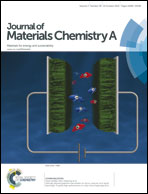Vertically aligned graphene nanosheets on silicon using an ionic liquid electrolyte: towards high performance on-chip micro-supercapacitors
Abstract
Vertically oriented graphene nanosheets were synthesized by an alternative and simple approach based on electron cyclotron resonance-plasma enhanced chemical vapor deposition (ECR-CVD) onto highly doped silicon substrates. The as-grown graphene electrodes were employed in a symmetric micro-supercapacitor using an aprotic ionic liquid [N-methyl-N-propylpyrrolidinium bis(trifluoromethylsulfonylimide); PYR13TFSI] as electrolyte. The device was able to deliver an outstanding specific capacitance value of 2 mF cm−2, a power density value of 4 mW cm−2 and an energy density value of 4 μW h cm−2 operating at a large and stable cell voltage of 4 V with a quasi-ideal capacitive behaviour. Moreover, the lifetime of the device exhibited a remarkable electrochemical stability retaining 80% of the initial capacitance after 150 000 galvanostatic charge–discharge cycles at a high current density of 1 mA cm−2. This excellent electrochemical performance results from the obtained channel-based 3-D graphene network promoting rapid electrolyte ion-transport and short diffusion paths.

- This article is part of the themed collections: JMC A Top Picks web collection: Advances in supercapacitors and 2015 Journal of Materials Chemistry A Hot Papers

 Please wait while we load your content...
Please wait while we load your content...